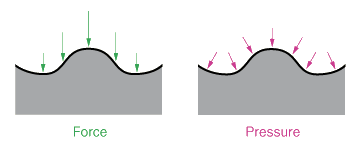Pressures | |
| |
Click Play to watch the video: ![]()
A pressure definition consists of two components:
- Transmission surface
- Magnitude
The pressure magnitude is specified in units of force per area; this magnitude is applied
normal to the transmission surface at every point on the surface. Unlike a force, which
always acts in a single direction, a pressure is applied normal to all regions of a
surface during the entire simulation, regardless of the surface curvature. 
Pressures typically represent the forces exerted by a gas on the walls of a container, such as air in a balloon. However, a pressure load can also be used to model any evenly distributed force across an area, such as the contact forces between two closely fitting, conforming parts.